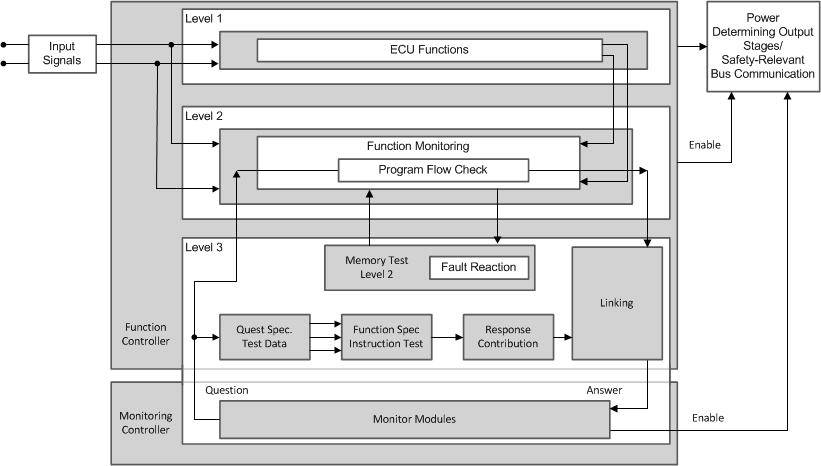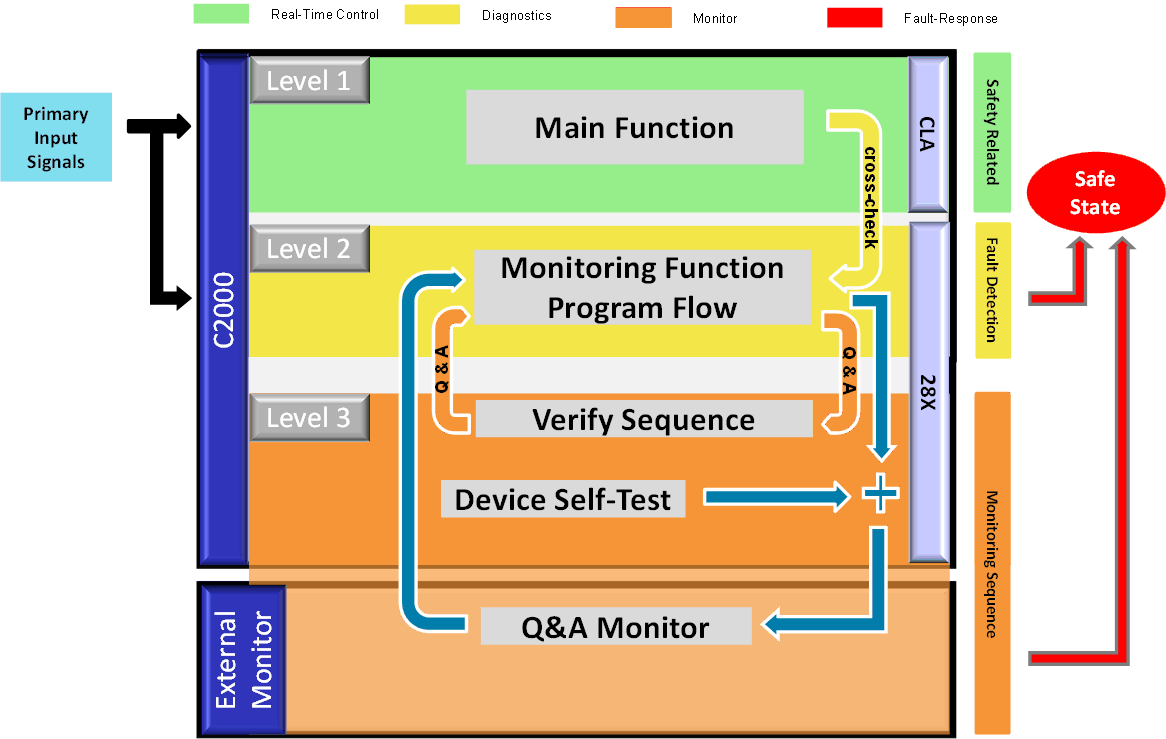SPRUI78D March 2019 – January 2022 TMS320F28075 , TMS320F28075-Q1 , TMS320F28076 , TMS320F28374D , TMS320F28374S , TMS320F28375D , TMS320F28375S , TMS320F28375S-Q1 , TMS320F28376D , TMS320F28376S , TMS320F28377D , TMS320F28377D-Q1 , TMS320F28377S , TMS320F28377S-Q1 , TMS320F28378D , TMS320F28378S , TMS320F28379D , TMS320F28379D-Q1 , TMS320F28379S
- Trademarks
- 1 Introduction
- 2 System Integrator Development Interface Agreement
- 3 C2000 Development Process for Management of Systematic Faults
- 4 TMS320F2837xD/S and TMS320F2807x MCU Architecture for Management of Random Faults
- 5 Brief Description of Safety Elements
-
6 Brief Description of Diagnostics
- 6.1
C2000 MCU Infrastructure Components
- 6.1.1 Clock Integrity Check Using CPU Timer
- 6.1.2 Clock Integrity Check Using HRPWM
- 6.1.3 EALLOW and MEALLOW Protection for Critical Registers
- 6.1.4 Efuse Autoload Self-Test
- 6.1.5 Efuse ECC
- 6.1.6 Efuse ECC Logic Self-Test
- 6.1.7 External Clock Monitoring via XCLKOUT
- 6.1.8 External Monitoring of Warm Reset (XRSn)
- 6.1.9 External Voltage Supervisor
- 6.1.10 External Watchdog
- 6.1.11 Glitch Filtering on Reset Pins
- 6.1.12 Hardware Disable of JTAG Port
- 6.1.13 Internal Watchdog (WD)
- 6.1.14 Lock Mechanism for Control Registers
- 6.1.15 Missing Clock Detect (MCD)
- 6.1.16 NMIWD Reset Functionality
- 6.1.17 NMIWD Shadow Registers
- 6.1.18 Multi-Bit Enable Keys for Control Registers
- 6.1.19 Online Monitoring of Temperature
- 6.1.20 Periodic Software Read Back of Static Configuration Registers
- 6.1.21 Peripheral Clock Gating (PCLKCR)
- 6.1.22 Peripheral Soft Reset (SOFTPRES)
- 6.1.23 PLL Lock Profiling Using On-Chip Timer
- 6.1.24 Reset Cause Information
- 6.1.25 Software Read Back of Written Configuration
- 6.1.26 Software Test of ERRORSTS Functionality
- 6.1.27 Software Test of Missing Clock Detect Functionality
- 6.1.28 Software Test of Reset
- 6.1.29 Software Test of Watchdog(WD) Operation
- 6.2
Processing Elements
- 6.2.1 CLA Handling of Illegal Operation and Illegal Results
- 6.2.2 CLA Liveness Check Using CPU
- 6.2.3 CPU Hardware Built-In Self-Test (HWBIST)
- 6.2.4 CPU Hardware Built-In Self-Test (HWBIST) Auto-Coverage
- 6.2.5 CPU Hardware Built-In Self-Test (HWBIST) Fault Injection Capability
- 6.2.6 CPU Hardware Built-In Self-Test (HWBIST) Timeout Feature
- 6.2.7 CPU Handling of Illegal Operation, Illegal Results and Instruction Trapping
- 6.2.8 Reciprocal Comparison by Software
- 6.2.9 Software Test of CLA
- 6.2.10 Stack Overflow Detection
- 6.2.11 VCU CRC Check of Static Memory Contents
- 6.2.12 VCU CRC Auto Coverage
- 6.2.13 Disabling of Unused CLA Task Trigger Sources
- 6.3
Memory (Flash, SRAM and ROM)
- 6.3.1 Bit Multiplexing in Flash Memory Array
- 6.3.2 Bit Multiplexing in SRAM Memory Array
- 6.3.3 Data Scrubbing to Detect/Correct Memory Errors
- 6.3.4 Flash ECC
- 6.3.5 Flash Program Verify and Erase Verify Check
- 6.3.6 Software Test of ECC Logic
- 6.3.7 Software Test of Flash Prefetch, Data Cache and Wait-States
- 6.3.8 Access Protection Mechanism for Memories
- 6.3.9 SRAM ECC
- 6.3.10 SRAM Parity
- 6.3.11 Software Test of Parity Logic
- 6.3.12 Software Test of SRAM
- 6.4
On-Chip Communication Including Bus-Arbitration
- 6.4.1 1oo2 Software Voting Using Secondary Free Running Counter
- 6.4.2 DMA Overflow Interrupt
- 6.4.3 Event Timestamping Using IPC Counter
- 6.4.4 Maintaining Interrupt Handler for Unused Interrupts
- 6.4.5 Majority Voting and Error Detection of Link Pointer
- 6.4.6 PIE Double SRAM Comparison Check
- 6.4.7 PIE Double SRAM Hardware Comparison
- 6.4.8 Power-Up Pre-Operational Security Checks
- 6.4.9 Software Check of X-BAR Flag
- 6.4.10 Software Test of ePIE Operation Including Error Tests
- 6.4.11 Disabling of Unused DMA Trigger Sources
- 6.4.12 IPC 64-Bit Counter Value Plausibility Check
- 6.5
Digital I/O
- 6.5.1 ECAP Application Level Safety Mechanism
- 6.5.2 ePWM Application Level Safety Mechanism
- 6.5.3 ePWM Fault Detection Using XBAR
- 6.5.4 ePWM Synchronization Check
- 6.5.5 eQEP Application Level Safety Mechanisms
- 6.5.6 eQEP Quadrature Watchdog
- 6.5.7 eQEP Software Test of Quadrature Watchdog Functionality
- 6.5.8 Hardware Redundancy
- 6.5.9 HRPWM Built-In Self-Check and Diagnostic Capabilities
- 6.5.10 Information Redundancy Techniques
- 6.5.11 Monitoring of ePWM by eCAP
- 6.5.12 Monitoring of ePWM by ADC
- 6.5.13 Online Monitoring of Interrupts and Events
- 6.5.14 SDFM Comparator Filter for Online Monitoring
- 6.5.15 SD Modulator Clock Fail Detection Mechanism
- 6.5.16 Software Test of Function Including Error Tests
- 6.6
Analogue I/O
- 6.6.1 ADC Information Redundancy Techniques
- 6.6.2 ADC Input Signal Integrity Check
- 6.6.3 ADC Signal Quality Check by Varying Acquisition Window
- 6.6.4 CMPSS Ramp Generator Functionality Check
- 6.6.5 DAC to ADC Loopback Check
- 6.6.6 DAC to Comparator Loopback Check
- 6.6.7 Opens/Shorts Detection Circuit for ADC
- 6.6.8 VDAC Conversion by ADC
- 6.6.9 Disabling Unused Sources of SOC Inputs to ADC
- 6.7
Data Transmission
- 6.7.1 Bit Error Detection
- 6.7.2 CRC in Message
- 6.7.3 DCAN Acknowledge Error Detection
- 6.7.4 DCAN Form Error Detection
- 6.7.5 DCAN Stuff Error Detection
- 6.7.6 EMIF Access Latency Profiling Using On-Chip Timer
- 6.7.7 EMIF Access Protection Mechanism
- 6.7.8 EMIF Asynchronous Memory Timeout Protection Mechanism
- 6.7.9 I2C Access Latency Profiling Using On-Chip Timer
- 6.7.10 Information Redundancy Techniques Including End-to-End Safeing
- 6.7.11 I2C Data Acknowledge Check
- 6.7.12 McBSP Receiver Overrun Detection
- 6.7.13 McBSP Receiver Sync Error Detection
- 6.7.14 McBSP Transmitter Sync Error Detection
- 6.7.15 McBSP Transmitter Underflow Detection
- 6.7.16 Parity in Message
- 6.7.17 SCI Break Error Detection
- 6.7.18 SCI Frame Error Detection
- 6.7.19 SCI Overrun Error Detection
- 6.7.20 Software Test of Function Using I/O Loopback
- 6.7.21 SPI Data Overrun Detection
- 6.7.22 Transmission Redundancy
- 6.1
C2000 MCU Infrastructure Components
- 7 Safety Architecture Configurations
- 8 Terms and Definitions
- 9 Summary of Safety Features and Diagnostics
- 10References
- 11Revision History
4.1.1 VDA E-GAS Monitoring Concept
The standardized E-GAS monitoring concept [6] for engine management systems generated by the German VDA working group “E-Gas-Arbeitskreis” is an example of a well-trusted safety-architecture that may be used for applications other than engine management systems provided it fits the purpose of the new application in terms of diagnosis feasibility, environment constraints, time constraints, robustness, and so forth [7]. For more information, see Figure 4-2.
 Figure 4-2 E-GAS System Overview From Standard
Figure 4-2 E-GAS System Overview From StandardThe TMS320F2837xD/S and TMS320F2807x MCU device family supports heterogeneous asymmetric architecture and their functional safety features lend themselves to an E-GAS concept implementation at system level as indicated in Figure 4-3. In the first level (Level 1), the functions required for the system mission are computed. Second level (Level 2) checks the correct formation in first level based on selected set of parameters. Third level (Level 3) implements an additional external monitoring element, for the correct carrying out of the mission in the first level and/or monitoring in the second level. The exact functional safety implementation and the modules used for realizing Level 1 and Level 2 and the external monitoring device for realizing Level 3 are left to the system designer. Though Figure 4-3 indicates CLA implementing Level1 and CPU(28x) implementing Level2 of the EGAS monitoring concept, both the processing units are capable of implementing either of the levels. The application can determine the partitioning based on the system requirements.
 Figure 4-3 VDA E-Gas Monitoring Concept Applied to C2000 MCU
Figure 4-3 VDA E-Gas Monitoring Concept Applied to C2000 MCU